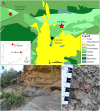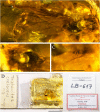A new genus of dance fly (Diptera: Empidoidea: Hybotidae) from Cretaceous Spanish ambers and introduction to the fossiliferous amber outcrop of La Hoya (Castellón Province, Spain)
- PMID: 36655053
- PMCID: PMC9841903
- DOI: 10.7717/peerj.14692
A new genus of dance fly (Diptera: Empidoidea: Hybotidae) from Cretaceous Spanish ambers and introduction to the fossiliferous amber outcrop of La Hoya (Castellón Province, Spain)
Abstract
Hybotidae fly species, also known as dance flies, in Cretaceous ambers have been described from Lebanon, France, Myanmar, Russia, and Canada. Here we describe Grimaldipeza coelica gen. et sp. n., and recognize another two un-named species, in Spanish amber from the middle Albian El Soplao and lower Cenomanian La Hoya outcrops. The fore tibial gland is present in the new genus, which is characteristic of the family Hybotidae. We compare Grimaldipeza coelica gen. et sp. n. with the holotypes of Trichinites cretaceus Hennig, 1970 and Ecommocydromia difficilis Schlüter, 1978, and clarify some morphological details present in the latter two species. Further taxonomic placement beyond family of the here described new genus was not possible and remains incertae sedis within Hybotidae until extant subfamilies are better defined. We provide new paleoecological data of the hybotids, together with paleogeographical and life paleoenvironmental notes. A table with the known Cretaceous Hybotidae is provided. Furthermore, the La Hoya amber-bearing outcrop is described in detail, filling the information gap for this deposit.
Keywords: Amber; Amber-bearing outcrop; Ecommocydromia; New genus; New species; Trichinites.
© 2023 Solórzano-Kraemer et al.
Conflict of interest statement
The authors declare that they have no competing interests.
Figures










References
-
- Almera J, Anadón P, Godoy A. Cartografía geológica y memoria explicativa. In: Barnolas A, editor. Mapa Geológico de España 1:50.000, Hoja 591 Mora de Rubielos. Madrid: Instituto Geológico y Minero de España; 1977. pp. 23–28.
-
- Alonso J, Arillo A, Barrón E, Corral JC, Grimalt J, López JF, López R, Martínez-Delclòs X, Ortuño VM, Peñalver E, Trincão PR. A new fossil resin with biological inclusions in Lower Cretaceous deposits from Alava (northern Spain, Basque-Cantabrian Basin) Journal of Paleontology. 2000;74:158–178. doi: 10.1666/0022-3360(2000)074. - DOI
-
- Álvarez-Parra S, Peñalver E, Nel A, Delclòs X. New barklice (Psocodea, Trogiomorpha) from Lower Cretaceous Spanish amber. Papers in Palaeontology. 2022;8(3):e1436. doi: 10.1002/spp2.1436. - DOI
-
- Álvarez-Parra S, Pérez-de la Fuente R, Peñalver E, Barrón E, Alcalá L, Pérez-Cano J, Martín-Closas C, Trabelsi K, Meléndez N, López Del Valle R, Lozano RP, Peris D, Rodrigo A, Sarto i Monteys V, Bueno-Cebollada CA, Menor-Salván C, Philippe M, Sánchez-García A, Peña-Kairath C, Arillo A, Espílez E, Mampel L, Delclòs X. Dinosaur bonebed amber from an original swamp forest soil. eLife. 2021;10:275. doi: 10.7554/eLife.72477. - DOI - PMC - PubMed
-
- Arillo A, Peñalver E, Delclòs X. Microphorites (Diptera: Dolichopodidae) from the Lower Cretaceous amber of San Just (Spain), and the co-occurrence of two ceratopogonid species in Spanish amber deposits. Zootaxa. 2008;1920(1):29–40. doi: 10.11646/ZOOTAXA.1920.1.2. - DOI
Publication types
MeSH terms
Substances
LinkOut - more resources
Full Text Sources
Miscellaneous

